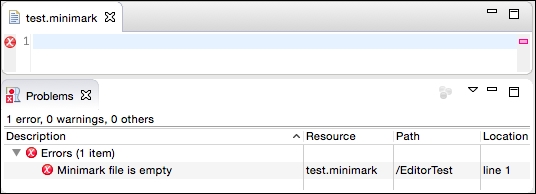The current implementation has a flaw, in that it doesn't appear to fix the problems after they have been resolved. That's because the marker types are kept associated with a resource even if that resource is changed. The reason this isn't seen in Java files is that the builder wipes out all (Java) errors prior to the start of a build, and then adds new ones as applicable. To avoid wiping out other plug-ins' markers, each marker has an associated marker type. JDT uses this to distinguish between its markers and others contributed by different systems. This can be done for MinimarkMarker instances as well.
- Open the
plugin.xmlfile in thecom.packtpub.e4.minimark.uiproject. Add the following extension to define aMinimarkMarker:<extension id="com.packtpub.e4.minimark.ui.MinimarkMarker" name="Minimark Marker" point="org.eclipse.core.resources.markers"> <persistent value="false"/> <super type="org.eclipse.core.resources.problemmarker"/> </extension>
- To use this marker when the error is created, instead of using
IMarker.PROBLEM, use its extension ID from theplugin.xmlin theprocessResourcemethod of theMinimarkVisitorclass:// IMarker marker = resource.createMarker(IMarker.PROBLEM); IMarker marker = resource.createMarker( "com.packtpub.e4.minimark.ui.MinimarkMarker");
- At the start of the
processResourcemethod, flush all the markers associated with the resource of this type:resource.deleteMarkers( "com.packtpub.e4.minimark.ui.MinimarkMarker", true, IResource.DEPTH_INFINITE);
- Run the Eclipse instance, and verify that as soon as some content is put in a
.minimarkfile, the errors are cleared. Delete the content, save the file, and the errors should re-appear. - Finally, the editor doesn't show up warnings in the column. To make that happen, change the superclass of the
MinimarkEditorclass fromAbstractEditortoAbstractDecoratedTextEditor.Run the target Eclipse instance again. Now errors will be reported in the editor as well:
Now the custom markers for the resource are being deleted at the start of a build, and if there's a problem a marker will be automatically added. When the problem is resolved, the resource's markers are automatically deleted anyway.
In the deletion code, the boolean argument says whether to delete markers that are a subtype of that marker type or not. The second argument says what happens in the case that it's a folder or other container, and if deletion should recurse.
Generally builders delete and create a specific type of problem marker, so that they do not affect the other markers that may be associated with that resource. This allows other contributors (such as the spell checking editor) to raise warnings or informational dialogs that are not cleaned by a particular builder.
